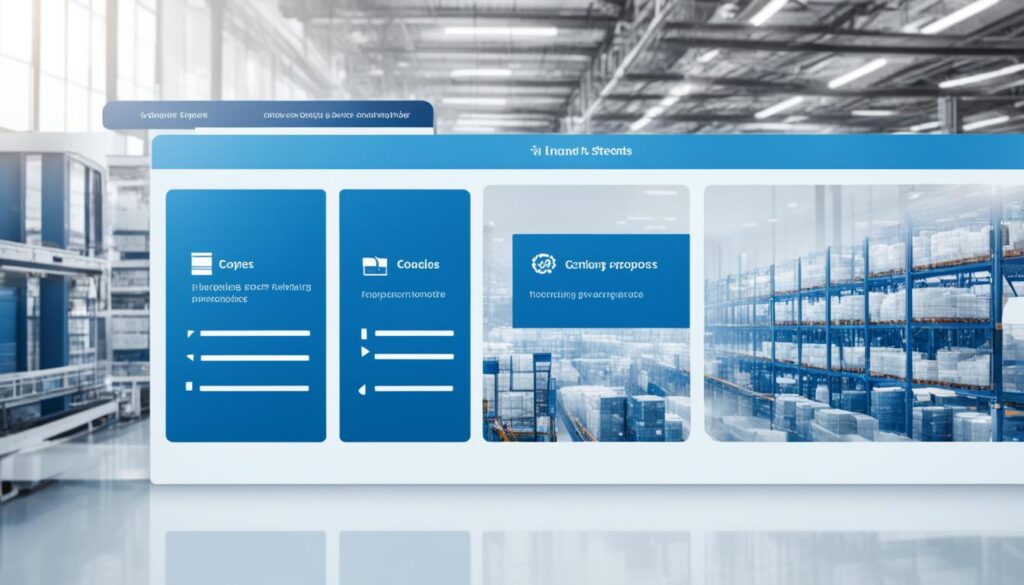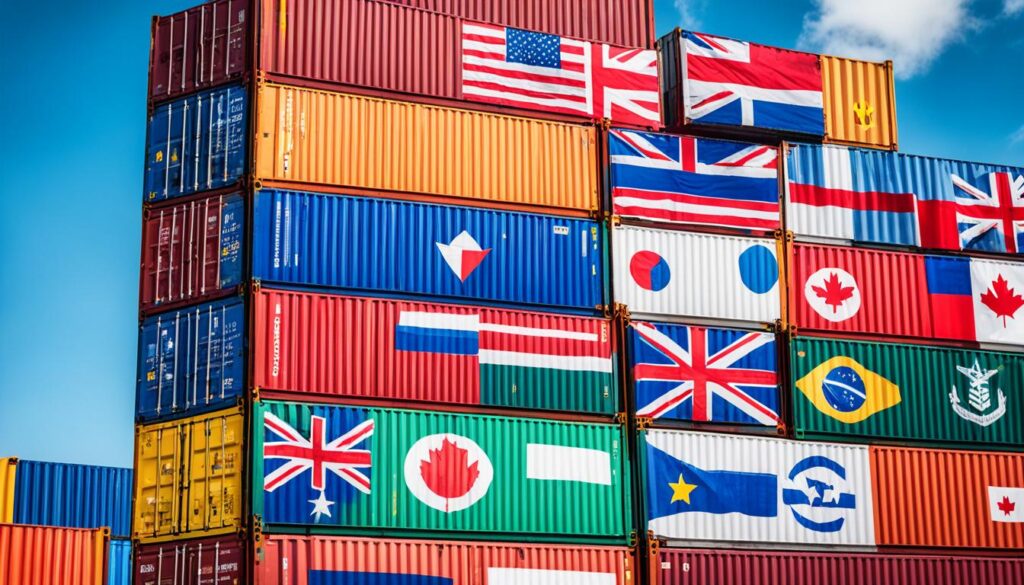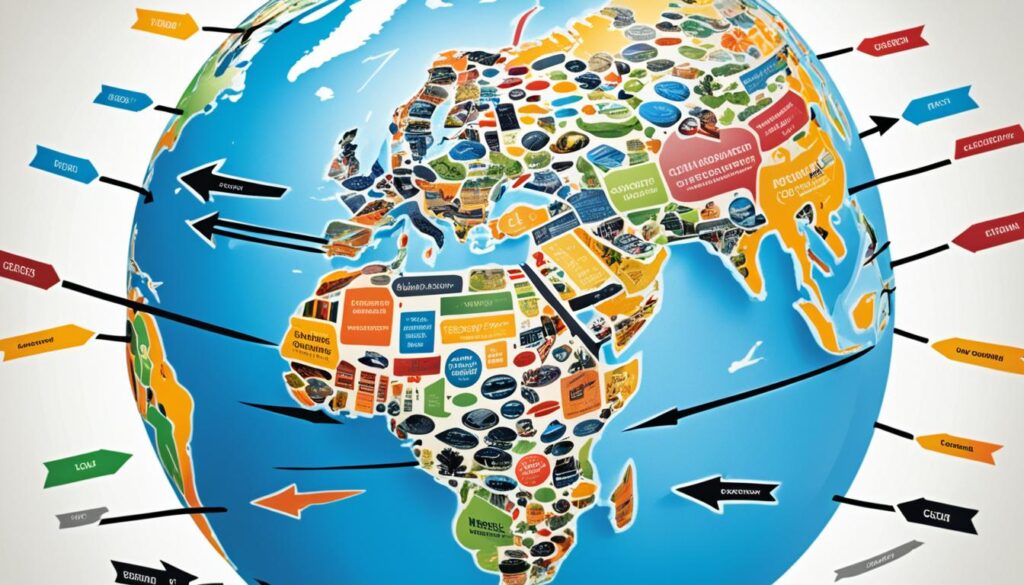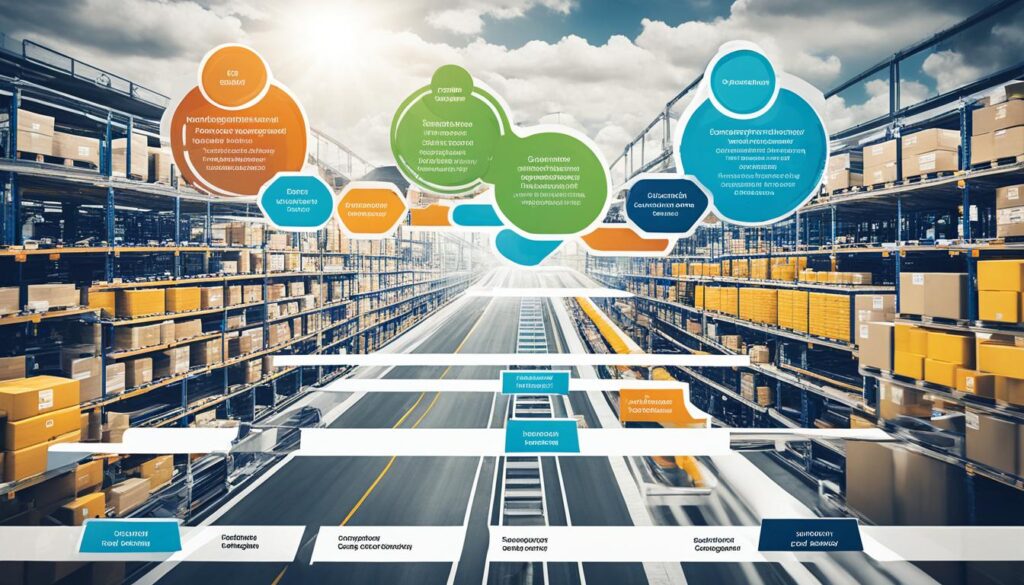Have you ever wondered how businesses manage to navigate through the complex web of trade restrictions and still thrive in global markets? Despite the numerous challenges posed by import regulations, export limitations, and other international trade barriers, successful companies find a way to overcome these obstacles and continue to expand their reach. But how do they do it?
In this article, I will delve into the intricacies of trade restrictions and provide insights into how businesses can effectively navigate this landscape. We will explore the various forms of trade barriers, including customs duties, trade embargoes, trade quotas, and tariff restrictions. By understanding these barriers and developing strategies to overcome them, businesses can ensure compliance, minimize risks, and seize the opportunities presented by global markets.
Key Takeaways:
- Trade restrictions, such as import regulations and export limitations, can pose significant challenges for businesses operating in global markets.
- Customs duties, trade embargoes, trade quotas, and tariff restrictions are common forms of trade barriers.
- Successfully navigating trade restrictions requires a thorough understanding of international trade laws and regulations.
- By ensuring compliance and developing effective strategies, businesses can mitigate the impact of trade restrictions and unlock global opportunities.
- International marketing success relies on a multidimensional approach that addresses trade barriers while leveraging free trade agreements and complying with advertising and marketing standards.
Understanding Import Regulations
Import regulations play a crucial role in international trade. Each country has specific requirements and documentation standards that must be met to ensure the safety, quality, and conformity of imported products. These regulations encompass aspects such as custom requirements, product standards, tariffs, and discriminatory barriers. Complying with import regulations is vital for businesses to successfully enter foreign markets and avoid any legal issues.
When importing goods, it is essential to understand the custom requirements of the destination country. This includes providing accurate and complete documentation, such as invoices, packing lists, certificates of origin, and import licenses. Failure to comply with these requirements can result in delays, fines, or even the refusal of entry for the imported goods.
Product standards are another key aspect of import regulations. Each country may have specific standards and technical requirements that imported products must meet to ensure consumer safety, health, and quality. These standards can include regulations related to product labeling, packaging, testing, and certifications. Adhering to these standards is crucial to avoid penalties, product recalls, and damage to brand reputation.
Tariffs, or import duties, are taxes imposed on imported goods. They are a common component of import regulations and can significantly affect the cost of imported products. Tariffs can vary widely between different countries and can be applied based on factors such as the product type, its value, or its country of origin. Businesses need to understand the tariff rates and classifications for their imported goods to accurately calculate the cost of the products and plan their pricing strategies.
“Complying with import regulations is vital for businesses to successfully enter foreign markets and avoid any legal issues.”
Discriminatory barriers are import regulations that discriminate against foreign companies or products in favor of domestic industries. These barriers can take various forms, such as local content requirements, government procurement preferences, or technical standards that favor domestic products. Understanding and navigating these discriminatory barriers is crucial for businesses to ensure fair competition and access to foreign markets.
Import Regulations Checklist
To navigate import regulations effectively, it is essential to follow a step-by-step checklist to ensure compliance:
- Research the import regulations of the target country: Understand the specific requirements, documentation standards, and product standards of the destination country.
- Obtain the necessary import licenses and permits: Identify the licenses or permits required for the imported goods and ensure timely application and approval.
- Ensure accurate and complete documentation: Prepare all required documents, including invoices, packing lists, certificates of origin, and import licenses, to facilitate smooth customs clearance.
- Comply with product standards: Ensure that the imported products meet the safety, quality, and technical standards of the destination country. Get the necessary certifications, conduct product testing if required, and ensure proper labeling and packaging.
- Understand tariff rates and classifications: Determine the applicable tariff rates and classifications for the imported goods to calculate the cost of the products accurately.
- Navigate discriminatory barriers: Identify any discriminatory barriers that may exist in the target market and develop strategies to overcome them, such as seeking exemptions or establishing local partnerships.
By understanding and complying with import regulations, businesses can minimize risks, ensure a smooth import process, and establish a strong presence in foreign markets.
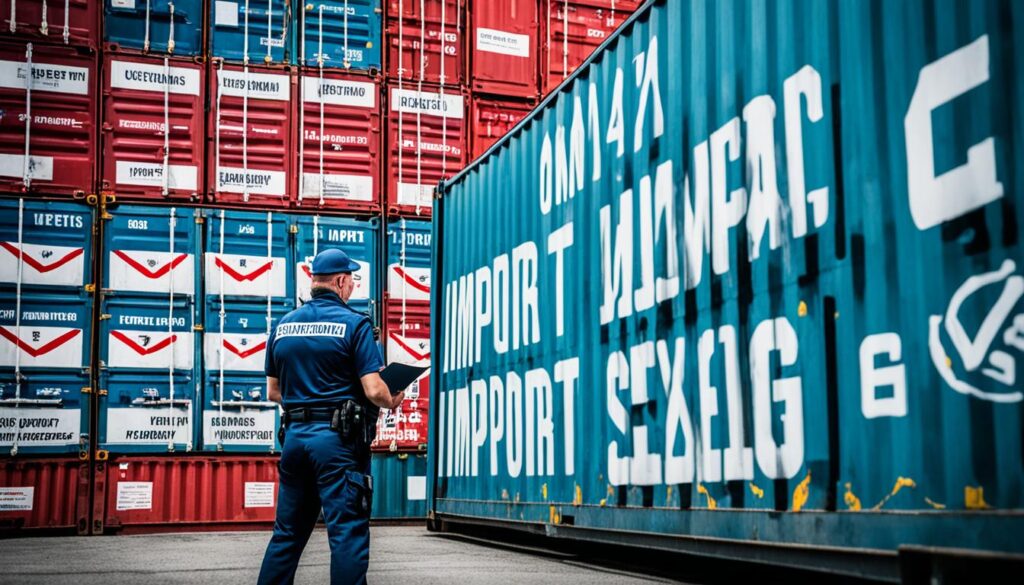
Managing Export Controls
Export controls play a crucial role in international trade, ensuring the proper regulation of the outbound flow of products and technologies. As businesses engage in global markets, it is essential to understand and manage export controls to comply with legal requirements, safeguard national security, and align with foreign policy objectives.
One prominent example of export controls is the Export Administration Regulations (EAR) in the United States. The EAR govern the export and re-export of specific commodities, software, and technology. Exporters must adhere to these regulations, including obtaining export licenses when necessary, to ensure compliance and mitigate risks.
By implementing export controls, countries aim to protect their national security interests and fulfill their foreign policy objectives. Exporting certain goods and technologies may pose risks, such as facilitating unauthorized proliferation of weapons, supporting terrorism, or violating human rights. Export controls help prevent such risks by regulating the export of sensitive items.
Export Licenses and Compliance
Obtaining an export license is a crucial step for businesses planning to export controlled items. An export license acts as authorization from the government to engage in specific export activities and ensures compliance with applicable regulations.
To determine if an export license is required, businesses need to:
- Identify the Export Control Classification Number (ECCN) for the goods or technologies being exported.
- Consult the Commerce Control List (CCL) or other relevant regulations to check if an export license is needed.
- Submit an export license application to the relevant government agency, providing information on the proposed export, end-user, and end-use.
- Comply with any additional requirements, such as recordkeeping and reporting.
Ensuring compliance with export controls is vital for businesses to avoid penalties, reputational damage, and legal consequences. Mistakenly exporting controlled items without the necessary licenses can lead to significant fines, imprisonment, or even the loss of export privileges.
Managing Export Controls effectively
Effectively managing export controls requires a comprehensive understanding of applicable regulations, including changes and updates. Businesses should establish robust internal compliance programs, implement regular training sessions for employees involved in export activities, and maintain up-to-date records of export transactions.
“Export controls are a vital aspect of international marketing. By complying with regulations and securing proper export licenses, businesses can navigate global markets while adhering to national security and foreign policy objectives.” – Jane McDonnell, International Trade Compliance Expert
Furthermore, it is always advisable for businesses to work closely with legal experts, consultants, and professional organizations specializing in export control compliance. Their expertise can provide valuable guidance and support in managing complex export control requirements.
Summary
Managing export controls is essential for businesses engaged in international marketing to ensure compliance with regulations, protect national security interests, and align with foreign policy objectives. Obtaining export licenses, ensuring compliance with applicable regulations, and implementing robust internal compliance programs are key steps in navigating export controls effectively.
Next, we will explore the benefits and implications of leveraging free trade agreements in international marketing.

Leveraging Free Trade Agreements
Free Trade Agreements (FTAs) are vital tools for businesses engaged in international marketing. These agreements aim to promote trade liberalization by eliminating or reducing barriers such as tariffs, quotas, and other protectionist measures. By leveraging FTAs, businesses can gain a competitive advantage and access duty-free or preferential markets, leading to increased opportunities for growth and expansion.
The Benefits of Free Trade Agreements
One of the key advantages of FTAs is the elimination or reduction of tariffs. Tariffs are taxes imposed on imported goods and services, which can significantly impact the cost of doing business internationally. Through FTAs, businesses can enjoy tariff-free trade with partner countries, reducing the financial burden of import/export transactions and making products more competitive in foreign markets.
Furthermore, FTAs can also remove or decrease quotas, which are restrictions on the total quantity of a specific good or service that can be imported/exported within a given period. By eliminating quotas, FTAs allow businesses to expand their market reach and meet increasing demand without being hindered by arbitrary limitations.
Access to Preferential Markets
FTAs provide businesses with access to preferential markets, where they can take advantage of reduced or eliminated trade barriers. Preferential markets offer various benefits, such as lower or no tariffs, simplified customs procedures, and streamlined regulatory requirements. These advantages facilitate smoother and more cost-effective trade operations, allowing businesses to focus on market penetration and growth.
Understanding Specific Provisions and Rules
To fully leverage FTAs, businesses must have a comprehensive understanding of the specific provisions and rules outlined in each agreement. FTAs often have varying provisions, including rules of origin, dispute settlement mechanisms, and special treatment for certain industries or products. It is crucial for businesses to thoroughly familiarize themselves with the regulations and requirements of these agreements to ensure compliance and maximize the benefits they offer.
Case Study: The Trans-Pacific Partnership (TPP)
“The TPP was a comprehensive free trade agreement that aimed to deepen economic ties among its member countries. It covered various sectors, including goods, services, intellectual property, and investment. With the removal of tariffs and significant market access opportunities, the TPP opened up doors for businesses across the Asia-Pacific region, allowing them to tap into new markets and expand their global presence.”

In conclusion, free trade agreements play a crucial role in international marketing. By leveraging these agreements, businesses can benefit from trade liberalization, gain access to preferential markets, and reduce trade barriers such as tariffs and quotas. However, to fully capitalize on the opportunities presented by FTAs, it is essential for businesses to understand the specific provisions and rules of each agreement and ensure compliance with the associated regulations. By doing so, businesses can unlock the full potential of international marketing and expand their global opportunities.
Ensuring Compliance with Advertising and Marketing Standards
In international marketing, businesses must prioritize compliance with advertising and marketing standards to foster fair competition and safeguard consumer protection. The legal requirements and regulations governing advertising practices vary from country to country. For instance, in the United States, the Federal Trade Commission (FTC) enforces rigorous guidelines to ensure advertisements are truthful, non-deceptive, and evidence-based. It is crucial for businesses to understand and adhere to the specific requirements related to health claims, environmental marketing, online advertising, and telemarketing, among others, to avoid legal issues and maintain credibility in international markets.
When promoting products or services globally, businesses must be mindful of the diverse legal frameworks and cultural sensitivities within different markets. Respecting these standards and requirements is essential for businesses to build trust with consumers, establish a positive brand image, and foster long-term relationships.
Advertising Standards and Fair Competition
Compliance with advertising standards is vital to ensure fair competition among businesses operating in global markets. By adhering to these standards, companies can avoid engaging in misleading or deceptive practices that could harm competitors or mislead consumers. Upholding fair competition enables businesses to create a level playing field, encouraging innovation and providing consumers with accurate information to make informed purchasing decisions.
“As an international marketer, I prioritize fair competition by strictly adhering to advertising standards and emphasizing accurate, clear, and transparent communication in all my marketing materials. By doing so, I strive to create an environment where consumers can make well-informed choices and competing businesses can thrive based on their merits.”
Consumer Protection and Legal Requirements
Adhering to advertising and marketing standards also plays a critical role in consumer protection. Laws and regulations are in place to safeguard consumers from false or misleading claims, ensuring their safety and well-being. International marketers must be aware of consumer protection legislation in each target market and align their advertising practices accordingly.
By following these legal requirements, businesses demonstrate their commitment to providing accurate information, transparent pricing, and safe products or services. This fosters consumer trust, loyalty, and a positive brand reputation, which are essential for long-term business success.
Case Study: Advertising Standards in Global Markets

| Country | Advertising Standards |
|---|---|
| United States | The Federal Trade Commission (FTC) requires truthfulness, non-deceptiveness, and evidence-based claims in advertisements. |
| United Kingdom | The Advertising Standards Authority (ASA) regulates advertisements to ensure accuracy, honesty, and social responsibility. |
| Australia | The Australian Association of National Advertisers (AANA) enforces codes of ethics for advertisers, emphasizing truth and clarity in marketing communications. |
| Germany | The German Advertising Standards Council (Deutscher Werberat) monitors advertisements to prevent misleading or offensive content. |
This case study highlights the variations in advertising standards worldwide. Businesses must actively familiarize themselves with the specific regulations in each market they operate to avoid potential legal pitfalls and ensure compliance.
Overall, adhering to advertising and marketing standards is paramount for international marketers. By striving to comply with legal requirements, businesses can establish a foundation of trust, foster fair competition, and protect consumers, ultimately leading to sustainable growth and success in global markets.
Impact of Protectionist Policies
Protectionist policies are implemented by countries to restrict the importation of goods and services produced in foreign countries. These policies aim to protect domestic companies and workers from competition. Protectionist policies can take the form of import restrictions, tariffs, and quotas, which reduce the quantities of foreign goods and services supplied to the country. As a result, these policies shift the supply curve, raise prices, and reduce the equilibrium quantity of the restricted goods or services.
Protectionist policies, such as import restrictions, can create trade barriers that hinder international commerce. These barriers limit the entry of foreign goods into a country’s market, protecting domestic industries from foreign competition. Import restrictions can take the form of licensing requirements, product standards, or outright bans. These policies may be implemented to safeguard national security, protect local industries, or address concerns about unfair trade practices.
Protectionist policies aim to shield domestic companies and workers from the impact of global competition, ensuring the growth and stability of the domestic economy.
Tariffs, another form of protectionist policy, are taxes imposed on imported goods and services. They increase the cost of selling these products in the domestic market, making them less competitive compared to domestically produced goods. Tariffs can be specific (a fixed amount per unit) or ad valorem (a percentage of the product’s value). The imposition of tariffs restricts the supply of imported goods, leading to higher prices for consumers and reduced access to foreign products.
By protecting domestic industries, tariffs on imported goods can support the growth and development of key economic sectors.
Quotas are also protectionist measures that limit the quantity of foreign goods that can be imported into a country over a specific period. Quotas are often used to protect domestic industries by restricting competition from imports. Similar to tariffs, quotas reduce the supply of imported goods, leading to higher prices and limited availability for consumers. They can be implemented on a product-specific or country-specific basis, providing targeted protection to specific industries or trade partners.
Quotas can be utilized to maintain a balance between domestic production and imports, safeguarding domestic industries and reducing reliance on foreign goods.
The impact of protectionist policies can have both positive and negative consequences. On one hand, these policies aim to protect domestic industries, create jobs, and foster economic growth. By restricting imports, protectionist measures can also incentivize local production and promote self-sufficiency. On the other hand, protectionist policies can reduce consumer choice, increase prices, and limit access to foreign goods and services. These policies can also trigger retaliation from trading partners, leading to strained international relations and potential trade conflicts.

Understanding the impact of protectionist policies is crucial for businesses engaged in international trade. Such knowledge allows companies to navigate trade barriers effectively, develop strategies to mitigate risks, and identify opportunities in the global marketplace. By staying informed about changes in protectionist policies, businesses can adapt their supply chains, explore new markets, and maintain compliance to thrive in an ever-changing international trade landscape.
Understanding Tariffs
Tariffs are a form of tax imposed on imported goods and services. These tariffs, also known as customs duties or import duties, serve as a means for governments to regulate international trade and protect domestic industries. By levying taxes on imported goods, tariffs aim to raise the cost of selling these products, making them less competitive in the domestic market.
The average tariff rate varies across countries and depends on the specific products or sectors being imported. Tariffs can be ad valorem (a percentage of the import value) or specific (a fixed dollar amount per unit). The imposition of tariffs shifts the supply curve for goods to the left, reducing the quantity available to consumers and leading to an increase in the price of the protected goods.
Higher tariff rates can significantly impact international trade by increasing the prices of imported goods. This can have various consequences, including:
- Higher prices for consumers: As tariffs raise the cost of importing goods, businesses often pass on these additional costs to consumers, resulting in higher prices for the imported products.
- Reduced availability of imported goods: The shift in the supply curve caused by tariffs leads to a decrease in the quantity of imported goods available in the market, limiting consumer choices.
- Competitive disadvantage for exporters: Tariffs imposed by one country can prompt retaliatory actions from trading partners, resulting in increased barriers for exporting domestic goods and a potential decline in international competitiveness.
| Tariff Impact | Consequence |
|---|---|
| Increase in price of imported goods | Higher costs for consumers |
| Decrease in quantity available to consumers | Limited choice of imported goods |
| Potential retaliatory actions | Reduced export opportunities for domestic goods |
Despite their potential drawbacks, tariffs can also serve specific policy objectives. They can be used to protect domestic industries from foreign competition, incentivize domestic production, and address trade imbalances. However, it is important for businesses engaged in international trade to be aware of the potential impact of tariffs on their operations and explore strategies to mitigate the associated risks.
Examining Antidumping Proceedings
Antidumping proceedings play a vital role in addressing alleged unfair pricing by foreign firms. These proceedings are implemented as protectionist measures to ensure a level playing field in international trade. By filing charges against a foreign firm for charging an “unfair” price, typically below production cost or below the price charged in its home country, antidumping measures aim to prevent material harm to domestic industries.
However, the process of defining an unfair price and demonstrating material harm can be complex. It requires a thorough analysis of the specific economic factors and market conditions. Antidumping investigations involve in-depth examination of dumping margins, market share, and price trends. The outcome of these proceedings can vary, depending on the evidence and arguments presented by the concerned parties.
“Antidumping proceedings provide a way to protect domestic industries from unfair trade practices. However, it is essential that these proceedings are conducted fairly and based on accurate and comprehensive data.” – [Author Name]
Case Study: Antidumping Investigation against XYZ Company
To illustrate the complexities of antidumping proceedings, let’s examine a recent case involving XYZ Company, a leading manufacturer of steel products. XYZ’s steel exports to the United States were found to be priced significantly below fair market value, causing material harm to the domestic steel industry. As a result, an antidumping investigation was initiated to determine the appropriate measures to address this unfair trade practice.
The key steps involved in the antidumping investigation against XYZ Company were as follows:
- Initiation of Investigation: The U.S. Department of Commerce initiated an investigation based on a petition filed by the domestic steel industry, providing evidence of unfair pricing by XYZ Company.
- Data Collection and Analysis: Both XYZ Company and the domestic steel industry provided extensive data on pricing, production costs, and market conditions. The Department of Commerce thoroughly analyzed this data to determine the existence and extent of dumping.
- Verification and On-Site Visits: The Department of Commerce conducted on-site visits to XYZ Company’s facilities to verify the accuracy of the provided data and gather additional information for its analysis.
- Preliminary Determination: Based on the collected evidence, the Department of Commerce issued a preliminary determination, calculating the dumping margin and determining the material injury caused to the domestic steel industry.
- Opportunity for Rebuttal: XYZ Company had the opportunity to rebut the Department of Commerce’s preliminary determination and present any additional evidence supporting its position.
- Final Determination: After considering all the evidence and arguments presented by the concerned parties, the Department of Commerce issued a final determination, imposing punitive duties on XYZ Company’s steel exports to offset the unfair pricing and restore fair competition.
The table below provides an overview of the key findings and punitive duties imposed in the final determination:
| Exporting Company | Dumping Margin | Punitive Duties |
|---|---|---|
| XYZ Company | 25% | 10% ad valorem |
It is important to note that outcomes may vary in different antidumping cases, depending on the specific circumstances and evidence presented. Antidumping proceedings aim to strike a balance between protecting domestic industries from unfair trade practices and maintaining fair competition in the global market.
Understanding Quotas
Quotas are direct restrictions on the total quantity of a good or service that may be imported during a specified period. These import quotas limit the total supply of the restricted goods or services, resulting in an increase in the domestic price.
The imposition of quotas causes a shift in the supply curve to the left, reducing the quantity consumed. This reduction in quantity can have significant implications for both domestic industries and consumers.
Quotas are often utilized to protect domestic industries and prevent excessive competition from foreign imports. By limiting the quantity of imported goods, quotas provide domestic producers with a competitive advantage by increasing their market share and ensuring a stable demand for their products.
Impact of Quotas on Domestic Price
When quotas restrict the total quantity of imported goods, the supply of the restricted goods becomes limited. This limited supply, coupled with unchanged demand, leads to an increase in the domestic price of the goods or services affected by the quota.
The increase in the domestic price can have several consequences:
- Higher prices for consumers: Domestic consumers may experience an increase in prices for the restricted goods or services, which can impact their purchasing power and consumption patterns.
- Incentives for domestic production: The higher domestic price resulting from quotas can incentivize domestic producers to increase their production to meet the demand previously fulfilled by imports.
- Market distortions: Quotas can create market distortions by artificially limiting the quantity of goods available, leading to inefficient allocation of resources in the economy.
It is essential to note that the specific impact of quotas on domestic price depends on various factors, including the elasticity of demand and supply for the restricted goods, the size of the quota, and the level of competition in the domestic market.
Shift in the Supply Curve
Quotas have a direct effect on the supply curve of the restricted goods or services. By restricting the total quantity of imports, quotas shift the supply curve to the left, reducing the quantity available.
This shift in the supply curve indicates a decrease in the quantity supplied at any given price. As a result, the equilibrium price of the restricted goods increases, reflecting the limited supply and increased domestic demand.
Here is a visual representation of the supply curve shift caused by quotas:
| Price | Quantity Supplied before Quota | Quantity Supplied after Quota |
|---|---|---|
| $X | Q1 | Q2 |
| $Y (Equilibrium Price before Quota) | Q1 (Equilibrium Quantity before Quota) | Q2 (New Equilibrium Quantity after Quota) |
As illustrated in the table and graph, the imposition of quotas reduces the quantity supplied (from Q1 to Q2) and increases the equilibrium price (from $Y to $Z) of the restricted goods or services.
Examples of Quotas
“The European Union has implemented a quota system for the importation of beef from non-EU countries. This quota restricts the total quantity of beef that can be imported at a reduced tariff rate. Once the quota limit is reached, any additional imports face higher tariff rates.”
“The United States has implemented quotas on the imports of sugar. These quotas limit the quantity of sugar that can be imported from specific countries, protecting domestic sugar producers.”
These examples demonstrate the use of quotas as a policy tool to control import quantities and safeguard domestic industries.
Exploring Voluntary Export Restrictions
Voluntary export restrictions (VERs) are measures imposed by foreign firms to limit the quantity of goods they export to a particular country. These restrictions are often negotiated as a trade barrier to protect domestic industries and maintain market stability. Similar to quotas, VERs aim to raise prices and reduce the quantity consumed of the restricted goods or services.
Voluntary export restrictions can result from trade pressure exerted by domestic industries or negotiated agreements between countries. By agreeing to voluntarily restrict their exports, foreign firms gain market protection and ensure the sustainability of domestic industries in the importing country.
“Voluntary export restrictions provide a mechanism for countries to address concerns related to excessive imports and potential harm to domestic industries.”
These restrictions can have a significant impact on trade dynamics and market competition. While they are intended to protect domestic industries, they can also create challenges for consumers and businesses that rely on the restricted goods or services. As a result of VERs, prices of imported goods may increase, and consumers may have limited access to a diverse range of products.
It is important for businesses engaged in international trade to closely monitor voluntary export restrictions and understand their potential implications. By staying informed, businesses can anticipate changes in the availability and cost of imported goods, adapt their supply chains, and explore alternative sourcing options to mitigate the impact of these trade barriers.
Benefits and Challenges of Voluntary Export Restrictions
While voluntary export restrictions can provide temporary relief to domestic industries, they also come with certain benefits and challenges:
- Market Protection: VERs protect domestic industries from intense competition and provide an opportunity for these industries to strengthen their position in the market.
- Stability: By limiting the quantity of imports, VERs help maintain market stability by preventing excessive supply and potential disruptions.
- Costs for Consumers: Consumers may experience higher prices due to limited competition and reduced availability of imported goods.
- Inefficiencies: VERs can create inefficiencies in the market, as they restrict the free flow of goods and services, limiting consumer choice and potentially hindering innovation.
- Risk of Retaliation: Imposing voluntary export restrictions can result in trade tensions and potential retaliation from the exporting countries, leading to further disruptions in international trade.
Overall, voluntary export restrictions are a trade barrier used to safeguard domestic industries and ensure market stability. While they can provide short-term benefits for certain sectors, their long-term impact on global trade and consumer welfare should be carefully considered and managed.
Case Study: Voluntary Export Restrictions in the Automotive Industry
The automotive industry has witnessed the implementation of voluntary export restrictions in the past. One notable example is the agreement reached between Japan and the United States in the 1980s to limit Japanese automobile exports to the U.S. market. This voluntary export restriction aimed to protect the domestic U.S. automakers from intense competition and provide a period for them to restructure and enhance their competitiveness. The VER was phased out in the early 1990s as the U.S. automakers regained their foothold in the market.
| Year | Japanese Auto Exports to the U.S. | Voluntary Export Restrictions |
|---|---|---|
| 1980 | 1.99 million | — |
| 1981 | 1.88 million | — |
| 1982 | 1.81 million | Implemented |
| 1983 | 1.68 million | Implemented |
| 1984 | 1.59 million | Implemented |
| 1985 | 1.80 million | Implemented |
The voluntary export restrictions in the automotive industry provide a real-world example of how these measures can be used to protect domestic industries and support their recovery in the face of intense competition.
Examining Other Trade Barriers
In addition to tariffs, quotas, and voluntary export restrictions, businesses engaged in international marketing may encounter various other trade barriers. These barriers include safety standards, labeling requirements, pollution controls, and quality restrictions. While these measures aim to protect consumers or the environment, they can inadvertently restrict imports and impact international trade.
Understanding and complying with these additional trade barriers is essential for businesses seeking to navigate the complexities of global markets. By ensuring compliance with safety standards, businesses can demonstrate their commitment to providing safe and reliable products to consumers.
Labeling requirements play a critical role in international trade, providing consumers with essential information about the origin, contents, and potential risks of products. Complying with these requirements enables businesses to gain the trust of customers and increase their market access.
Pollution controls are another trade barrier that businesses must consider. These measures aim to protect the environment by imposing restrictions on imported goods that may contribute to pollution or environmental degradation. Adhering to these controls helps businesses demonstrate their commitment to sustainability and environmental responsibility.
Lastly, quality restrictions can impact international trade by requiring imported goods to meet specific quality standards. Compliance with these restrictions ensures that businesses deliver products that meet or exceed customer expectations, bolstering their reputation in the global marketplace.
Overall, understanding and proactively addressing trade barriers beyond tariffs and quotas is crucial for businesses engaged in international marketing. By staying informed and compliant, businesses can navigate the intricacies of global trade, unlock new market opportunities, and establish themselves as trustworthy partners in the international arena.
Conclusion
International marketing offers tremendous opportunities for businesses to expand into new markets and reach a global audience. However, for success in global trade, it is crucial to have a comprehensive understanding of the legal framework that governs international marketing. This includes a thorough knowledge of import regulations, export controls, free trade agreements, and advertising standards.
Adhering to import regulations is essential to ensure compliance with specific requirements and standards set by different countries. It involves meeting custom requirements, product standards, and navigating tariffs and discriminatory barriers. By complying with these regulations, businesses can confidently enter foreign markets without facing any legal issues.
In addition, managing export controls, such as the Export Administration Regulations (EAR), is vital to comply with national security and foreign policy objectives. Obtaining the necessary export licenses ensures adherence to these regulations, enabling businesses to leverage global opportunities and expand their reach.
Moreover, understanding and leveraging free trade agreements (FTAs) can provide businesses with a competitive advantage. By eliminating or reducing barriers like tariffs and quotas, FTAs open up preferential markets, allowing businesses to access them and enhance their international marketing strategies.
By navigating the legal framework, complying with regulations, and understanding the global landscape, businesses can unlock the full potential of international marketing. With a strong focus on compliance, they can mitigate risks and seize the global opportunities that await them.

